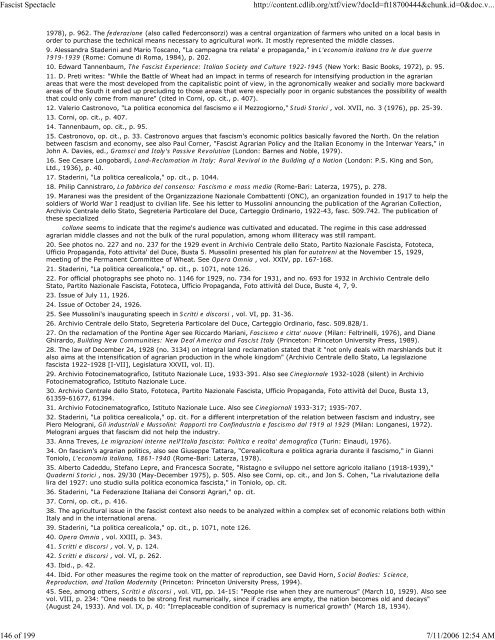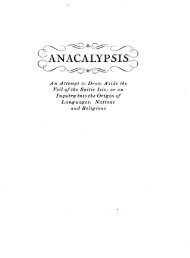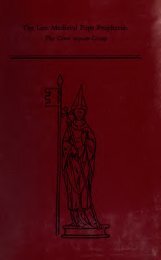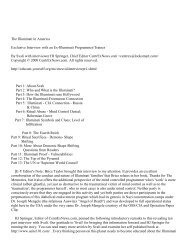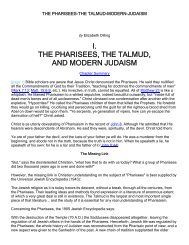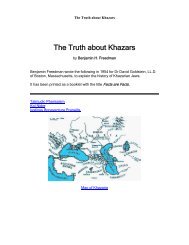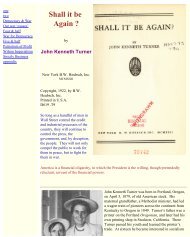You also want an ePaper? Increase the reach of your titles
YUMPU automatically turns print PDFs into web optimized ePapers that Google loves.
<strong>Fascist</strong> <strong>Spectacle</strong> http://content.cdlib.org/xtf/view?docId=ft18700444&chunk.id=0&doc.v...<br />
1978), p. 962. The federazione (also called Federconsorzi) was a central organization of farmers who united on a local basis in<br />
order to purchase the technical means necessary to agricultural work. It mostly represented the middle classes.<br />
9. Alessandra Staderini and Mario Toscano, "La campagna tra relata' e propaganda," in L'economia italiana tra le due guerre<br />
1919-1939 (Rome: Comune di Roma, 1984), p. 202.<br />
10. Edward Tannenbaum, The <strong>Fascist</strong> Experience: Italian Society and Culture 1922-1945 (New York: Basic Books, 1972), p. 95.<br />
11. D. Preti writes: "While the Battle of Wheat had an impact in terms of research for intensifying production in the agrarian<br />
areas that were the most developed from the capitalistic point of view, in the agronomically weaker and socially more backward<br />
areas of the South it ended up precluding to those areas that were especially poor in organic substances the possibility of wealth<br />
that could only come from manure" (cited in Corni, op. cit., p. 407).<br />
12. Valerio Castronovo, "La politica economica del fascismo e il Mezzogiorno," Studi Storici , vol. XVII, no. 3 (1976), pp. 25-39.<br />
13. Corni, op. cit., p. 407.<br />
14. Tannenbaum, op. cit., p. 95.<br />
15. Castronovo, op. cit., p. 33. Castronovo argues that fascism's economic politics basically favored the North. On the relation<br />
between fascism and economy, see also Paul Corner, "<strong>Fascist</strong> Agrarian Policy and the Italian Economy in the Interwar Years," in<br />
John A. Davies, ed., Gramsci and Italy's Passive Revolution (London: Barnes and Noble, 1979).<br />
16. See Cesare Longobardi, Land-Reclamation in Italy: Rural Revival in the Building of a Nation (London: P.S. King and Son,<br />
Ltd., 1936), p. 40.<br />
17. Staderini, "La politica cerealicola," op. cit., p. 1044.<br />
18. Philip Cannistraro, La fabbrica del consenso: Fascismo e mass media (Rome-Bari: Laterza, 1975), p. 278.<br />
19. Maranesi was the president of the Organizzazione Nazionale Combattenti (ONC), an organization founded in 1917 to help the<br />
soldiers of World War I readjust to civilian life. See his letter to Mussolini announcing the publication of the Agrarian Collection,<br />
Archivio Centrale dello Stato, Segreteria Particolare del Duce, Carteggio Ordinario, 1922-43, fasc. 509.742. The publication of<br />
these specialized<br />
collane seems to indicate that the regime's audience was cultivated and educated. The regime in this case addressed<br />
agrarian middle classes and not the bulk of the rural population, among whom illiteracy was still rampant.<br />
20. See photos no. 227 and no. 237 for the 1929 event in Archivio Centrale dello Stato, Partito Nazionale <strong>Fascist</strong>a, Fototeca,<br />
Ufficio Propaganda, Foto attivita' del Duce, Busta 5. Mussolini presented his plan for autotreni at the November 15, 1929,<br />
meeting of the Permanent Committee of Wheat. See Opera Omnia , vol. XXIV, pp. 167-168.<br />
21. Staderini, "La politica cerealicola," op. cit., p. 1071, note 126.<br />
22. For official photographs see photo no. 1146 for 1929, no. 734 for 1931, and no. 693 for 1932 in Archivio Centrale dello<br />
Stato, Partito Nazionale <strong>Fascist</strong>a, Fototeca, Ufficio Propaganda, Foto attività del Duce, Buste 4, 7, 9.<br />
23. Issue of July 11, 1926.<br />
24. Issue of October 24, 1926.<br />
25. See Mussolini's inaugurating speech in Scritti e discorsi , vol. VI, pp. 31-36.<br />
26. Archivio Centrale dello Stato, Segreteria Particolare del Duce, Carteggio Ordinario, fasc. 509.828/1.<br />
27. On the reclamation of the Pontine Ager see Riccardo Mariani, Fascismo e citta' nuove (Milan: Feltrinelli, 1976), and Diane<br />
Ghirardo, Building New Communities: New Deal America and <strong>Fascist</strong> Italy (Princeton: Princeton University Press, 1989).<br />
28. The law of December 24, 1928 (no. 3134) on integral land reclamation stated that it "not only deals with marshlands but it<br />
also aims at the intensification of agrarian production in the whole kingdom" (Archivio Centrale dello Stato, La legislazione<br />
fascista 1922-1928 [I-VII], Legislatura XXVII, vol. II).<br />
29. Archivio Fotocinematografico, Istituto Nazionale Luce, 1933-391. Also see Cinegiornale 1932-1028 (silent) in Archivio<br />
Fotocinematografico, Istituto Nazionale Luce.<br />
30. Archivio Centrale dello Stato, Fototeca, Partito Nazionale <strong>Fascist</strong>a, Ufficio Propaganda, Foto attività del Duce, Busta 13,<br />
61359-61677, 61394.<br />
31. Archivio Fotocinematografico, Istituto Nazionale Luce. Also see Cinegiornali 1933-317; 1935-707.<br />
32. Staderini, "La politica cerealicola," op. cit. For a different interpretation of the relation between fascism and industry, see<br />
Piero Melograni, Gli industriali e Mussolini: Rapporti tra Confindustria e fascismo dal 1919 al 1929 (Milan: Longanesi, 1972).<br />
Melograni argues that fascism did not help the industry.<br />
33. Anna Treves, Le migrazioni interne nell'Italia fascista: Politica e realta' demografica (Turin: Einaudi, 1976).<br />
34. On fascism's agrarian politics, also see Giuseppe Tattara, "Cerealicoltura e politica agraria durante il fascismo," in Gianni<br />
Toniolo, L'economia italiana, 1861-1940 (Rome-Bari: Laterza, 1978).<br />
35. Alberto Cadeddu, Stefano Lepre, and Francesca Socrate, "Ristagno e sviluppo nel settore agricolo italiano (1918-1939),"<br />
Quaderni Storici , nos. 29/30 (May-December 1975), p. 505. Also see Corni, op. cit., and Jon S. Cohen, "La rivalutazione della<br />
lira del 1927: uno studio sulla politica economica fascista," in Toniolo, op. cit.<br />
36. Staderini, "La Federazione Italiana dei Consorzi Agrari," op. cit.<br />
37. Corni, op. cit., p. 416.<br />
38. The agricultural issue in the fascist context also needs to be analyzed within a complex set of economic relations both within<br />
Italy and in the international arena.<br />
39. Staderini, "La politica cerealicola," op. cit., p. 1071, note 126.<br />
40. Opera Omnia , vol. XXIII, p. 343.<br />
41. Scritti e discorsi , vol. V, p. 124.<br />
42. Scritti e discorsi , vol. VI, p. 262.<br />
43. Ibid., p. 42.<br />
44. Ibid. For other measures the regime took on the matter of reproduction, see David Horn, Social Bodies: Science,<br />
Reproduction, and Italian Modernity (Princeton: Princeton University Press, 1994).<br />
45. See, among others, Scritti e discorsi , vol. VII, pp. 14-15: "People rise when they are numerous" (March 10, 1929). Also see<br />
vol. VIII, p. 234: "One needs to be strong first numerically, since if cradles are empty, the nation becomes old and decays"<br />
(August 24, 1933). And vol. IX, p. 40: "Irreplaceable condition of supremacy is numerical growth" (March 18, 1934).<br />
146 of 199 7/11/2006 12:54 AM


